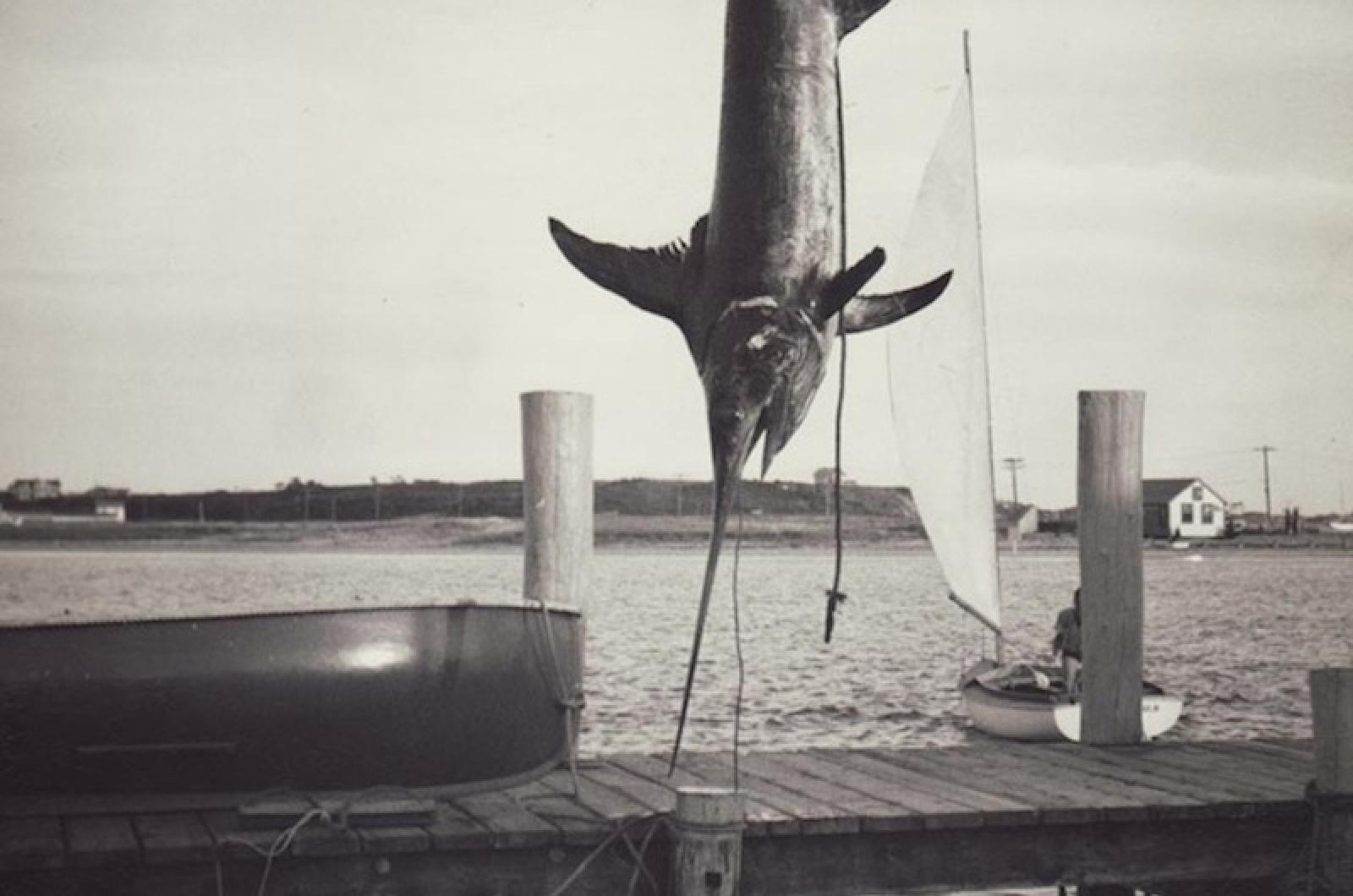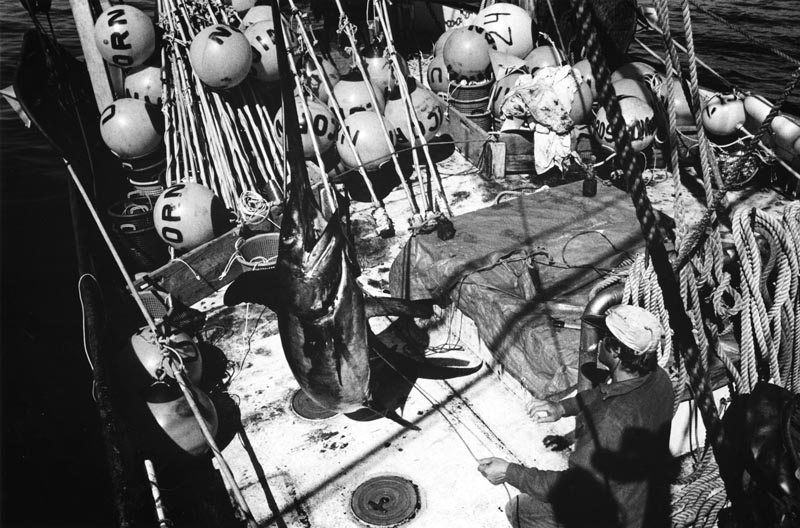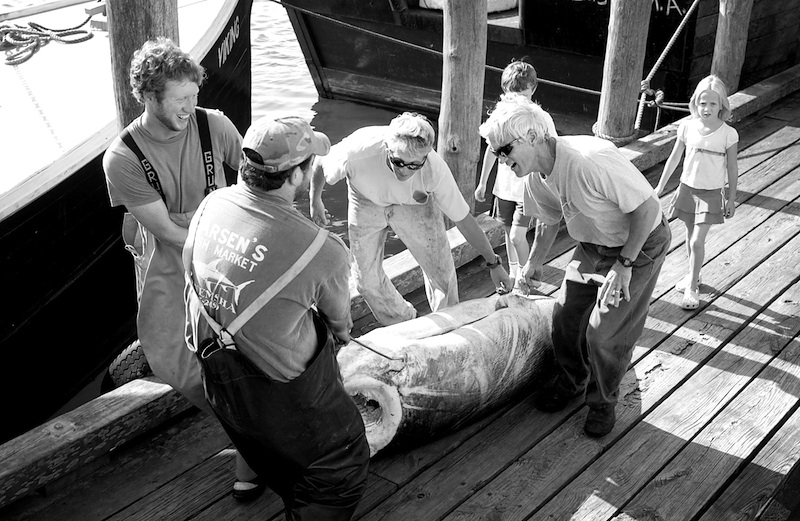Thirty deepwater fishermen from around New England expressed their approval at a meeting in Gloucester Thursday night for a new proposal to open up swordfishing to rod and reel and harpoon fishermen. Gregory Mayhew and his son Todd, both Menemsha fishermen, attended, as did Alex Friedman, president of the Martha’s Vineyard/Dukes County Fishermen’s Association.
“There was consensus by all the fishermen that it was nice to see the government instead of restricting fishermen, helping to open up access. There is a glimmer of hope for the future,” Gregory Mayhew, 67, said after the meeting.
Mr. Friedman, 41, said he, too, was encouraged by what he saw and heard at the meeting.
“As many people noted, this was not just a historical meeting. There was universal goodwill between the federal regulators, the fishermen and the scientists. Everyone agrees we have an opportunity here to do it right, and make it sustainable for the fish and for the small local fishing fleets.”
Swordfish was once one of the most important fish in the area, but for the last 20 years numbers have been in decline. Recently, though, stocks have rebounded and regulators have been looking at ways to relax the restrictive measures that had been created. The NOAA Fisheries Service is currently reviewing ways to allow more fishermen along the coast, from the Gulf of Maine to the Gulf of Mexico, to gain access. They call their regulatory change Amendment 8 to the 2006 Consolidated Highly Migratory Species Fishery Management Plan for Management of Atlantic Swordfish.
It is a long name for a long process that won’t take effect until the end of this year. Because swordfish appear in local waters in the summer, the rules won’t have an impact here until the summer of 2014.
As part of the draft, the federal fisheries managers are looking at imposing a limit of up to three fish per trip in this area. They are looking at a bag limit of one fish per day in southern Florida, two fish per day in the U.S. Caribbean and three fish per day in the Gulf of Mexico.
“We could adjust that number within the season,” higher or lower, depending on how well fishermen are taking the quota, Mr. Blankinship said.
Gregory Mayhew said that all of the 30 fishermen at the public hearing spoke favorably of access, but he also said that the fishermen wanted more of a trip limit. They complained that it was not economically viable to have a three fish trip limit. Mr. Mayhew said Florida fishermen have the unfair advantage of being able harvest year-round, whereas New England fishermen pointed out that they only have access in the summer months when the swordfish migrate north.
Randy Blankinship, a fisheries specialist with NOAA in St. Petersburg, Fla., said there have been plenty of comments for and against the changes. The proponents in this region are seeking more access to the fishery. The opponents are those who are already in the swordfishery, mostly long liners, who see the changes as a possible threat to their market.
“Swordfish is somewhat of a success story,” Mr. Blankinship said. “Currently swordfish are not overfished and they were considered overfished a decade ago,” he said.
North Atlantic swordfish are regulated by an international organization called ICCAT, which stands for the International Commission for the Conservation of Atlantic Tuna. The United States is a big player in the commission.
Last year, U.S. fishermen were given a quota of 7.85 million pounds, dressed weight. They only harvested 5.18 million pounds, or 66 per cent of their quota, Mr. Blankinship said. This was not due to a lack of fish. The lack of quota is tied to fishermen not being able to access the fish.
“Since 1999 there have been no new swordfish permits issued,” Mr. Blankinship said. “Over time, while the swordfishery was rebuilding, the fishing capacity did not grow. In fact it shrank.”
“NOAA is proposing a new open access permit to provide additional opportunities for fishermen with the goal of helping fishermen get more of our quota,” said Mr. Blankinship. NOAA is particularly interested in relaxing the access to those fishing groups that are more environmentally friendly.
“I know that the harpoon fishery has been important in the history of Martha’s Vineyard. This permit could, if finalized, allow additional fishermen to go harpooning,” Mr. Blankinship said.
Mr. Mayhew said his main purpose in going go to Gloucester last night was to persuade the regulators that harpooning is far more conservative than any of the other methods. He also wants a higher trip limit. He said harpoon fishermen only target and harvest adult swordfish. “There is no bycatch. It is a selective fishery. You don’t have to worry about getting undersized fish or sea turtles,” Mr. Mayhew said. This is often a problem with long-lining.
Mr. Mayhew said he wants a trip limit of 30 fish per trip. As successful as the fishery may appear, most harvestable swordfish in these waters are too far out at sea to be commercially accessible. He said going out to harvest three fish doesn’t cover the cost of the fuel and expenses.
“The closest swordfish [to the Vineyard] would be 80 miles south of the Vineyard. You hear rumors of some being as close as 20 miles, but it is still not economical,” Mr. Mayhew said. “Most of the swordfish are at least 150 miles southeast of the Vineyard. They are more at the eastern region of Georges Bank.”
Mr. Mayhew said long-lining fishermen represent 80 per cent of the fish landed. “Years before it was 100 per cent harpooned swordfish.”
Mr. Mayhew said he believes long-lining is responsible for the swordfish decline. The technique involves dropping miles and miles of monofilament line loaded with baited hooks off the stern.
“The last time I went swordfishing was in 2006,” Mr. Mayhew said. We made the trip with my three boys, Jeremy, Todd and Galen. We might have caught two.”
In the 1970s, Mr. Mayhew said he could recall bringing from 40 to 50 adult size swordfish to the Menemsha dock in just one trip. “Two-thirds of my income for the year was made [this way], from the 1970s to the early 1980s,” Mr. Mayhew said.
The federal fisheries has extended the public comment period for the swordfish plan from April 23 to May 8. A final plan won’t be released until the end of the summer.
“The process does take time and it is an important one,” Mr. Blankinship said.









Comments (2)
Comments
Comment policy »